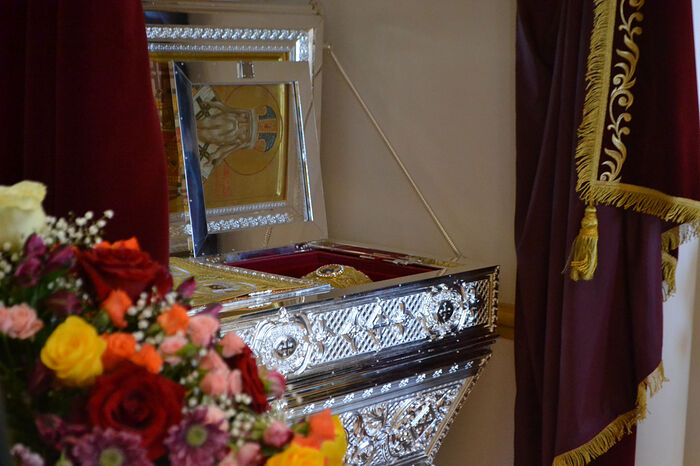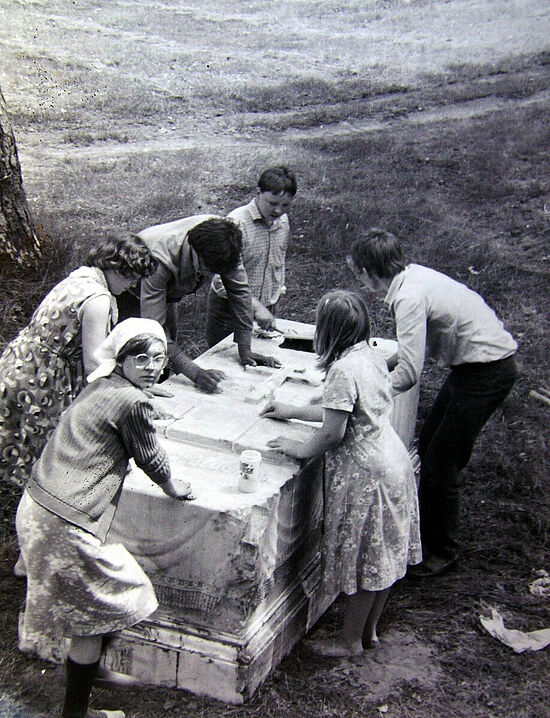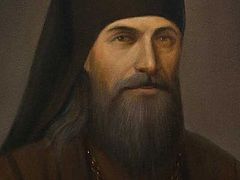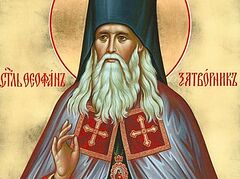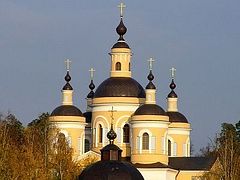Holy hierarch Theophan, namesake of Theophany, /
you enlightened many people by your teachings. /
Now that you stand before the throne of the Holy Trinity /
together with the angels, / pray without ceasing for us all.
Kontakion to the holy hierarch
In 1998, on the Feast of Holy Theophany, Archimandrite Georgiy (Tertyshnikov) and I left the academy together. A huge line was formed outside to recieve the holy water. As we were walking not far from the academic library, Fr. Georgiy said: “They fail to get people to go and vote, but here no one forces anyone but our people still flock to get holy water, and even hard frost wouldn’t scare them!”
As we were going on our way, he told me his joyful news. It was a special day for him – the day of repose of the Holy Hierarch Theophan (the patronal feast day of the church where the holy hierarch served daily while living in seclusion, and also his name, is derived from the Greek “Θεοφανής” translated as “God Manifest in the Flesh”). Fr. Georgiy explained that January 10 (January 23, New Style), the saint’s birthday, was set as the ecclesiastical commemoration day of the Holy Hierarch Theophan at his suggestion, since the typikon doesn’t state how to commemorate the saints on the feast of Theophany. Only after Fr. Georgiy died, at the request of the brethren of the Lavra and with the blessing of His Holiness Patriarch Kirill, the name of the Recluse of Vysha was added to the church-wide Menologion of the official calendar of the Moscow Patriarchate on the hierarch’s day of repose (January 6/19). 1
Archimandrite Georgiy was the first who popularized the legacy of the Holy Hierarch Theophan in contemporary history
Archimandrite Georgiy was the first to popularize the legacy of Holy Hierarch Theophan in modern history, and he explained that his writings remained truly relevant to our contemporaries as they offer answers to many challenging issues faced by modern society. A truly hard-working man, full of creative powers, Fr. Georgiy began to study the personality of the ascetic of Vysha and his spiritual heritage while still a student of the Moscow Theological Academy.
***
The life and rich spiritual heritage of Holy Hierarch Theophan are known to many people today. His numerous works on Christian virtue, translations of ascetic literary texts (including the translation of the “Philokalia”), his profound interpretations of Holy Scripture, letters to numerous people who sought his advice or spiritual help, and much more have been republished many times. But only a few know the story of discovery of the relics of the holy hierarch. Yet, the story of the return of his honorable relics to Vysha is closely connected with the Trinity-St. Sergius Lavra.
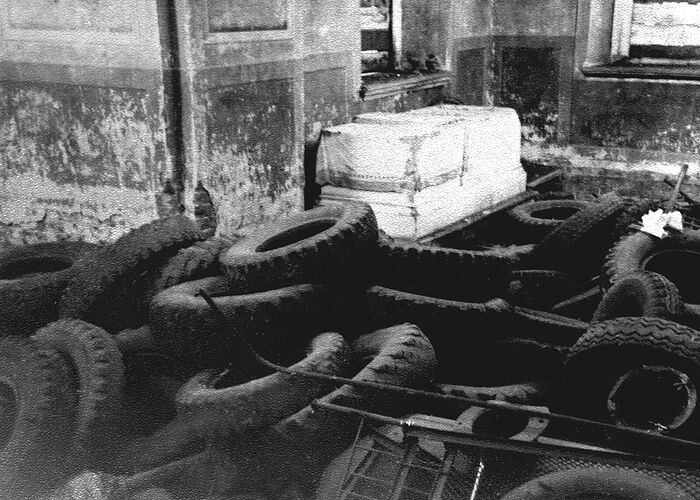 Tombstone of the Holy Hierarch in the cathedral, which had been turned a warehouse
Tombstone of the Holy Hierarch in the cathedral, which had been turned a warehouse
Bishop Theophan was buried in 1894 in the right-side Vladimir chapel of the Kazan Cathedral of the Vysha monastery, where he had lived in seclusion for twenty-two years. A tombstone of white marble depicting three books by the saint—the Russian version of the Philokalia, the Interpretation of the Apostolic Epistles, and Outline of Christian Moral Teaching—was erected over his grave.
In the 1920s, at the time of anti-religious persecution, the monastery was closed, the bell tower destroyed, its buildings and property nationalized, and its monks evicted. The monastery grounds were used to house a forestry agency, a state swine-raising farm, a children’s playground, and beginning from 1938, by the local psychiatric hospital. During these troubled times, the relics of the Holy Hierarch Theophan remained where they were before, in the desecrated Kazan Cathedral.
In the fall of 1972, Igumen Mark (Lozinsky), Professor of the Moscow Theological Academy, accompanied by Hieromonk Georgiy (Tertyshnikov), Rev. Fr. Georgiy Glazunov2 and Evgeny Didenko (future Archimandrite Eleutherius), traveled to the Vysha monastery. As Archpriest Georgiy Glazunov recalls, Fr. Georgiy (Tertyshnikov) went to Vysha several times—first alone, as a pilgrim, and then in a company of Igumen Mark and Evgeniy Didenko. He and Fr. Georgiy served a Panikhida over the desecrated tomb of Bishop Theophan and decided to take the saint’s honorable remains out of the half-ruined church.
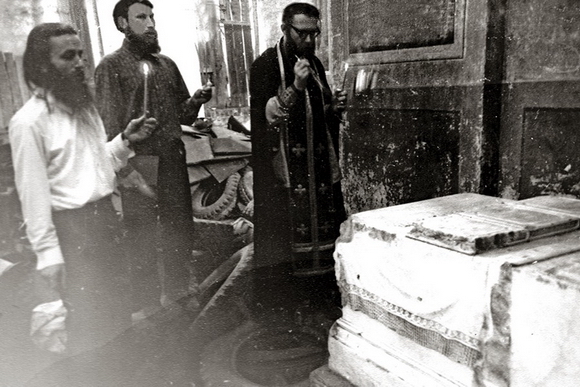 Panikhida at the tombstone of Bishop Theophan in the ruins of the Kazan Cathedral. Hieromonk Georgiy (Tertyshnikov), Rev. Fr. Georgiy Glazunov, Igumen Mark (Lozinsky). 1972.
Panikhida at the tombstone of Bishop Theophan in the ruins of the Kazan Cathedral. Hieromonk Georgiy (Tertyshnikov), Rev. Fr. Georgiy Glazunov, Igumen Mark (Lozinsky). 1972.
Along with Rev. Fr. Georgiy, they served the panikhida service and decided to remove the honorable remains of the holy hierarch out of the half-ruined church
It was impossible to uncover the relics right away, so they had to think through every detail. Rev. Fr. Georgiy made arrangements with the storekeeper3 that some visitors would arrive, purporting to be researchers, and she was to unlock the warehouse. He later recalled:
“Armed with a flashlight, Fr. Eleutherius and I went down into the crypt and cleaned the relics. Then we began to move the pieces of relics with our fingers from place to place and finally collected everything, including the spine and the bones. Then we began to collect the remaining ashes using a whisk broom and put them in cellophane. We also found the Gospel that was laid on the Vladyka’s chest. It was as good as new, except that its pages broke when opened, apparently because of dampness; but the seal looked as if it were brand new or placed there only recently. I handed the Gospel over to Fr. Mark. We took the relics to my house. That’s where a tall man wearing glasses, Fr. Mark’s confidant, arrived to collect the relics. He packed everything in oilcloths and placed them neatly in a suitcase. This is how the relics were transferred to the Lavra.”
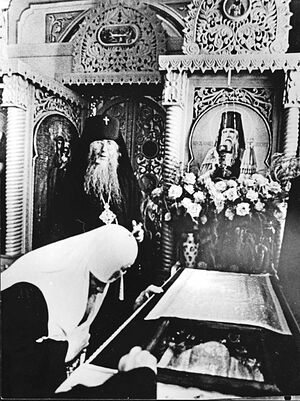 His Holiness Patriarch Alexiy II in the Church of St. Sergius of Radonezh in the village of Emmanuilovka, 2002. This took place in 1972. Back in the Lavra, Fr. Georgiy (Tertyshnikov), who had a medical education, had washed, organized, signed, and set the relics in order.
His Holiness Patriarch Alexiy II in the Church of St. Sergius of Radonezh in the village of Emmanuilovka, 2002. This took place in 1972. Back in the Lavra, Fr. Georgiy (Tertyshnikov), who had a medical education, had washed, organized, signed, and set the relics in order.
With the blessing of Archimandrite Kirill (Pavlov), the confessor of the Trinity-St. Sergius Lavra, the remains of Holy Hierarch Theophan were secretly kept in the Church of All Saints under the Lavra’s Dormition Cathedral. As Archimandrite Eleutherius recalls, they were placed on the left-hand side not far from the burial place of Patriarch Pimen. The relics were bricked up in the wall at around chest level.
“I don’t know who was privy to this secret other than Fr. Mark and Fr. Georgiy (Tertyshnikov),” Fr. Eleutherius told me. “Fr. Kirill knew about it. And then later, Fr. Georgiy told me that they are located there and that he was preparing the papers for the canonization of Bishop Theophan.”
The remains of the Holy Hierarch Theophan were secretly kept in the Church of All Saints under the Dormition Cathedral of the Lavra
In 1988, the relics of Bishop Theophan, placed in a small tomb, were transported to Ryazan. On June 5, the day before the Church-wide glorification, they were placed in the Church of St. Sergius of Radonezh in the village of Emmanuilovka. Here, in a new tomb under the canopy, they remained for another fourteen years.
In 1990, some of the buildings of the Vysha Monastery were returned to the Church and its restoration began. In 1993, the monastic life was restored and a women’s monastery was opened there. Divine services were held in the Dormition Church, the only one restored at that time, while the sisters had to reside outside the monastery walls because their living quarters were still occupied by the patients of the psychiatric hospital.
Finally, on June 29, 2002, the relics of the holy hierarch were transferred from the St. Sergius Church in the village of Emmanuilovka to the Dormition Church of the revived Vysha Monastery. The relics of the Recluse of Vysha returned to the monastery exactly thirty years after they were taken to the Lavra in 1972 to be saved from further desecration.

